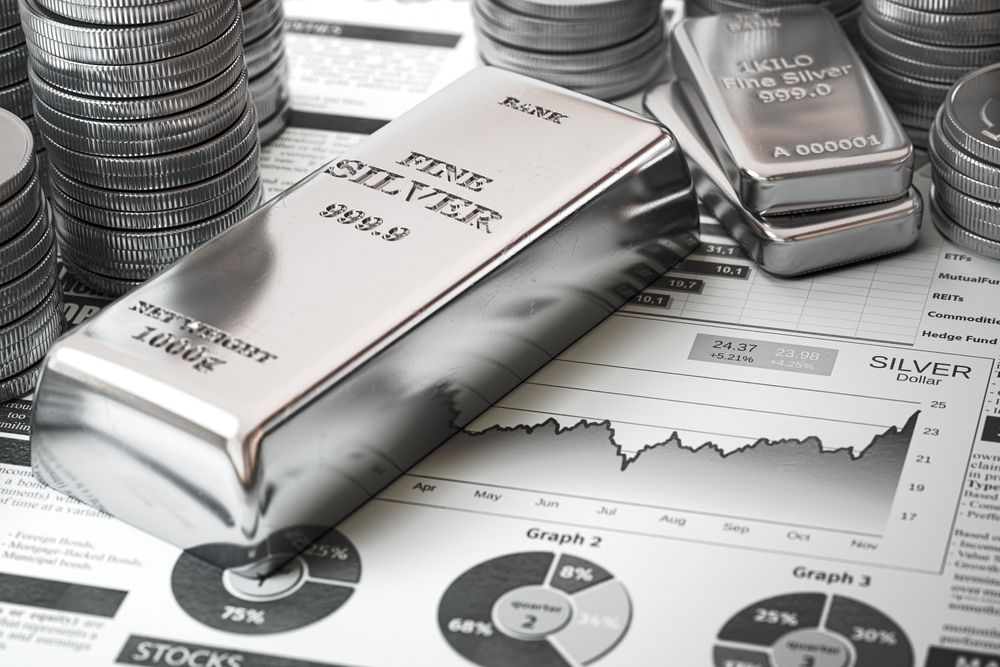A trader’s guide to silver

What is silver?
Silver – often referred to as the ‘white metal’ and denoted by the chemical symbol ‘Ag’ – is a commodity and a precious metal that’s known for its lustrous appearance, high conductivity and antimicrobial properties. It’s widely used in jewellery, healthcare, electronics and automotive manufacturing.
Originally traded in physical form, silver is now easily accessible through a variety of financial instruments such as futures, ETFs, and CFDs, making it a popular commodity for traders and investors around the globe who seek exposure to precious metals markets.
Why is silver an important commodity?
Silver is an important commodity due to its historical significance and its wide range of industrial applications. It has been used as currency since ancient civilisations, facilitating trade and commerce across regions.
Beyond its use in jewellery, silver's high electrical conductivity makes it essential in electronics, while its antimicrobial properties are valuable in healthcare. Additionally, silver’s dual role as both an industrial metal and a trading asset contributes to its relative price volatility, attracting traders looking to capitalise on market fluctuations.
What are the differences between silver and gold?
Silver and gold are precious metals with long trading histories. Their prices often move in tandem, yet their price correlation has varied on many occasions.
Periods of high correlation have included the 1970s, early 1980s and the ‘metals super cycle’ from 2002 to 2011. The metals super cycle was a period of sustained high prices that was part of a broader commodities boom at the time. It was driven by factors such as strong global economic growth, especially in emerging markets.
There have also been periods where gold and silver prices diverge. During the dot-com boom in the late 1990s and early 2000s, gold prices faced significant pressure, while silver’s industrial demand allowed it to remain relatively stable.
Here’s a summary of the key differences between trading the white and yellow metals:
|
Silver |
Gold |
|
|
Price per ounce |
Lower |
Higher |
|
Volatility |
Higher volatility; historically subject to significant price swings* |
Lower volatility; historically more stable price movements* |
|
Liquidity |
High liquidity |
Very high liquidity |
|
Demand |
Industrial, jewellery, trading, investment |
Central bank currency reserves, currency peg, investment, trading, jewellery. |
|
Price correlations |
Often closely tied to economic cycles, due to industrial demand |
Safe-haven asset: often inversely correlated with broader economic conditions |
|
Nickname |
‘White metal’ |
‘Yellow metal’ |
|
Accessibility |
Lower price point makes silver more accessible to a broader range of traders. |
Higher prices may be prohibitive to some traders. |
|
Potential trading strategies |
Swing trading Diversification |
Position trading Hedging |
*Past performance is not a reliable indicator of future results.
What’s the silver price history?
Silver's price history is characterised by significant fluctuations and it’s often closely tied to broader market movements, economic conditions and geopolitical events due to high industrial demand.
Silver futures were introduced on the Commodity Exchange in 1933, marking the beginning of standardised silver derivatives trading in the United States. The Commodity Futures Trading Commission (CFTC) was established in 1974, providing regulatory oversight for futures markets, including silver. This helped to increase confidence in silver derivatives and attract market participants.
During the 1970s, silver prices experienced a dramatic increase influenced by high inflation, geopolitical tensions and the Hunt Brothers’ attempts to corner the market. This culminated in a historic peak in 1980, as silver rose in response to the economic uncertainty triggered by the Iranian Revolution and the Soviet invasion of Afghanistan.
Silver prices remained relatively stable during the 1990s as global economic conditions improved and inflation rates decreased. During this period, silver's correlation with gold weakened, with the two metals often moving independently of each other.
Past performance is not a reliable indicator of future results.
The early 2000s marked the beginning of a new bull market for silver. The uptrend was influenced by increased industrial demand from emerging economies and growing investor interest in precious metals. While silver is often associated with gold, its price is more closely tied to industrial demand, which results in a stronger positive correlation with the US stock market. Despite this, during the 2008 Global Financial Crisis, silver's appeal briefly rose as a perceived safe-haven asset amid heightened economic uncertainty.
Silver reached another significant peak in 2011, driven by a combination of factors including quantitative easing policies, concerns about inflation, strong industrial demand and speculative trading – particularly with the growth of silver exchange-traded funds (ETFs). This rally was short-lived, and prices subsequently entered a multi-year downtrend as the Federal Reserve began to signal the tapering of quantitative easing, alongside a strengthening US dollar and reduced speculative interest.
The COVID-19 pandemic in 2020 initially caused a sharp decline in silver prices, followed by a strong recovery as investors sought safe-haven assets and governments implemented stimulus measures. Then, the ’silver squeeze’ of early 2021 demonstrated the potential for retail investors to influence the market, albeit temporarily. This event highlighted the growing influence of social media and online forums on commodity prices.
In the years following the COVID-19 pandemic, silver prices have experienced notable volatility. In 2022 and 2023, rising inflation and higher interest rates pressured silver prices while renewed demand for clean energy and electronics supported its value.
Which factors can influence silver’s live price?
Silver’s unique properties make it attractive for traders, industry participants, in jewellery and in ornamentation. Its live price may be influenced by factors such as:
Industrial demand – silver's unique properties make it essential in various industries including electronics, healthcare and automotive manufacturing. A growing global economy may boost industrial demand for silver, potentially leading to higher prices. Conversely, a slowdown in manufacturing or reduced economic growth could decrease demand, putting downward pressure on silver prices. Monitor economic indicators like Purchasing Managers' Index (PMI) releases to gauge industrial activity and anticipate shifts in silver demand.
Production techniques – silver is often found in combination with other precious metals and minerals like lead, copper, gold, and zinc. The efficiency of extraction and processing techniques can impact the global supply of silver. Technological advancements that improve extraction efficiency and increase the silver supply could potentially lower prices. Conversely, the depletion of higher-grade ores may require more advanced and costly extraction methods, reducing supply and potentially increasing prices.
Regulation and policy – government policies and central bank decisions can significantly influence silver prices. Interest rate cuts might reduce the carrying cost of holding non-yielding assets like precious metals, and possibly lead to higher silver prices. Conversely, higher interest rates could influence lower silver prices. Similarly, changes in environmental standards or mining permits can either restrict or enhance silver production.
What are the silver trading hours?
Silver futures and options are traded on COMEX (CME Group). Its trading hours are Sunday to Friday, from 11:00pm until 10:00pm UTC the following day – with a one hour break each day beginning at 10:00pm UTC.**
For traders dealing in physical silver, there is no theoretical limit to the trading hours. Refer to your local or preferred minting house or trading hall for trading hours.
If you choose to trade CFDs, you can follow the silver performance live in US dollars with our comprehensive silver price chart.
Monitoring the commodity’s activity can help you to keep an eye out for any key fundamental or technical events that may affect short-term movements in its value.
**Trading hours may differ depending on national holidays and daylight savings time.
How to trade silver with CFDs
Silver is a commodity that can be traded either on spot markets or via derivatives like CFDs, which derive their value from the underlying asset. For those dealing with physical contracts, significant costs such as storage and transportation may arise, potentially causing financial strain due to unexpected fees or delivery obligations.
To avoid these challenges, contracts for difference, or CFDs, allow speculation on silver prices without owning the asset. A CFD is a contract where one party agrees to pay the difference between the opening and closing prices of the asset.
Both methods offer the choice of using leverage, or margin trading, allowing you to control larger positions with less capital, which can enhance potential gains but also amplifies risks. Additionally, CFDs enable traders to go long (profiting from rising prices) or short (profiting from falling prices), providing flexibility in both bull and bear markets.
How to trade silver with futures
You can also trade silver using futures. Futures contracts are agreements to buy or sell silver at a specified price on a set future date. These contracts are standardised and traded on regulated exchanges, such as the COMEX (CME Group). Futures are typically used by both speculators and producers to hedge against future price changes, and they involve a firm obligation to fulfil the contract at expiration, unless closed out beforehand.
When you trade a futures CFD, you're speculating on the price movement of a futures contract without actually entering into the physical futures contract itself. This allows you to trade futures in a more flexible way, benefiting from leverage and smaller capital requirements, but without the obligation of settlement that comes with holding a physical futures contract to expiry.
Traders interested in silver might also look into shares issued by companies involved in the extraction, refining and distribution of silver, as well as silver products – such as Pan American Silver Corp, First Majestic Silver Corp and iShares SIlver Trust.
ETFs, options and mutual funds are also potential ways of gaining exposure to this commodity.
You can learn more about trading commodities with Capital.com in our comprehensive guide to commodity trading.
Create an account Open a demo account
FAQs
How do you buy silver on the stock market?
While silver itself is traded on commodity exchanges, you can gain exposure to silver on the stock market by investing in silver ETFs, which track the price of silver, or by purchasing shares of publicly listed companies involved in silver mining and production. These methods allow you to participate in silver price movements through the stock market infrastructure.
What is silver used for?
Silver has been historically used for currency and jewellery. Today, it plays a crucial role in electronics due to its excellent electrical conductivity, and in solar energy for photovoltaic cells. It’s also valued in the automotive industry for electrical components, and in medicine for its antimicrobial properties. Silver remains popular in jewellery and silverware and is actively traded as a precious metal for both diversification and profit-targeting strategies due to its price volatility.
What is the gold-silver ratio?
The gold-silver ratio measures the amount of silver it takes to purchase one ounce of gold. Traders use this ratio to assess the relative value of the two metals and identify trading opportunities. A high ratio may indicate that silver is undervalued relative to gold, while a low ratio suggests it may be overvalued.
Is silver a safe-haven asset?
Silver can exhibit a fluctuating price correlation with the US stock market, sometimes showing a negative relationship during economic downturns due to its role as a precious metal. However, silver's price is also strongly influenced by industrial demand, making it more volatile than traditional safe-haven assets like gold.
While silver can sometimes act as a hedge against economic uncertainties or as part of a diversification strategy with other precious metals, silver’s volatility means that it might not consistently serve as a safe-haven during market downturns nor remain stable during economic upturns.
What is the symbol for silver in the stock market?
Silver is a commodity and does not have a stock symbol like a publicly traded company. However, silver futures are often denoted by the symbol 'SI' on commodity exchanges like the COMEX. ETFs and mining companies related to silver each have their own ticker symbols, which can be found on their respective exchange listings.
Is silver more volatile than gold?
Silver’s relatively small market size and large industrial use contribute to increased price volatility than gold. It’s sensitive to economic cycles and this volatility can present opportunities for higher returns, but also increases risk. Consider appropriate risk management techniques when trading gold.
Visit our other complete trading guides

How to trade Coffee
